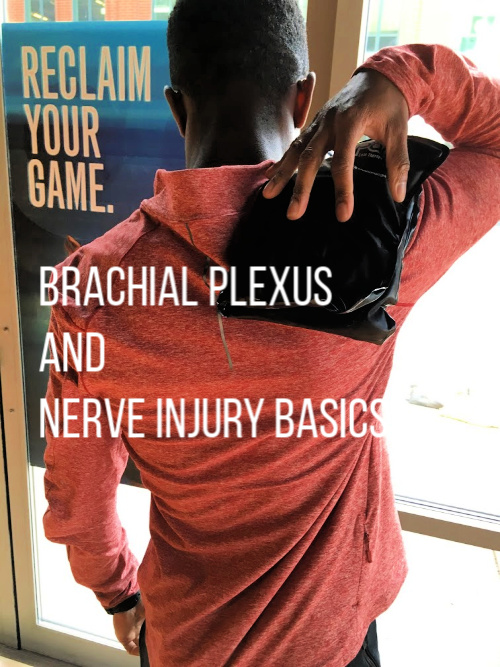Brachial Plexus and Nerve Injury Basics

Have you ever woken up with a completely numb hand or arm? Chances are that you were sleeping in a position that temporarily compressed a part of your brachial plexus, resulting in what is referred to as “Saturday Night Palsy” or a similar condition.
What is the brachial plexus?
“Brachial plexus” may sound like something from outer space, but let’s look at the Latin definitions:
Bracchialis means “arm” or “pertaining to the arm”
Plex means “a braid or network”
The brachial plexus is a bundle of nerves that runs from your neck, through your armpit, and branches out in various directions to innervate different areas of your arm and hand. These nerves are responsible for the movement of the muscles in the shoulder, arm, and hand, as well as for sensation in the arm.

Causes of brachial plexus injury
Brachial plexus injuries can be caused by stretching, compression, or cutting of any of the nerves in this intricate network. Mechanisms of injury include an excessive sudden stretch of the neck/shoulder (during a motor vehicle accident or during birth), collarbone or first rib injury, surgical complication, or compression from soft tissues (ie. swelling or muscle tightness).
Recovery
The severity of the injury and the ability for recovery depends on the degree of insult to the nerve structure. When you wake up with a limp arm after falling asleep with your arm under you or draped over something, there has been a minor injury to that nerve, called a neuropraxia, which heals almost right away. However, there is minor damage that can cause bigger issues if this happens often. If you experience this type of symptom frequently, or if it is worsening in intensity or frequency, tell your physical therapist or doctor.
More severe injuries are caused by larger insults to a nerve fiber. Axonotmesis describes medium grade injuries involving disruption of parts of the nerve, but not total rupture, as the outer sheath remains intact. The healing ability and timeline vary greatly within this category. Neurotmesis is the most severe, with the complete cutting of the nerve. Chances for nerve regeneration are low in these cases. More severe nerve injuries can result in deformities such as wrist drop, claw hand deformity, Erb’s palsy, depending on which nerve or nerve branch is damaged.
Physical therapy for brachial plexus injuries
Physical therapists treat patients with brachial plexus injuries all the time. We can help to retrain the muscles affected, alleviate pain, and also to identify and treat contributing factors including muscular imbalances, posture, sleeping, or working positions. Arm and hand function typically returns to 90-100% normal with physical therapy after a minor brachial plexus injury. A severe injury may require other treatments including surgery.